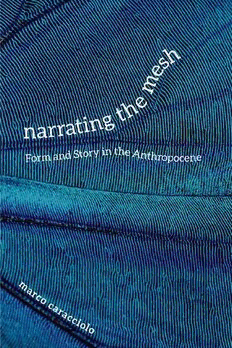
Narrating the Mesh: Form and Story in the Anthropocene PDF
Preview Narrating the Mesh: Form and Story in the Anthropocene
Narrating the Mesh All use subject to https://about.jstor.org/terms Under the Sign of Nature: Explorations in Ecocriticism Serenella Iovino, Anthony Lioi, and Kate Rigby, Editors Michael P. Branch, SueEllen Campbell, and John Tallmadge, Senior Advisory Editors All use subject to https://about.jstor.org/terms Narrating the Mesh FORM AND STORY IN THE ANTHROPOCENE Marco Caracciolo UNIVERSITY OF VIRGINIA PRESS CHARLOTTESVILLE AND LONDON All use subject to https://about.jstor.org/terms University of Virginia Press © 2021 by the Rector and Visitors of the University of Virginia All rights reserved Printed in the United States of America on acid- free paper First published 2021 9 8 7 6 5 4 3 2 1 Library of Congress Cataloging- in- Publication Data Names: Caracciolo, Marco, author. Title: Narrating the mesh : form and story in the anthropocene / Marco Caracciolo. Description: Charlottesville : University of Virginia Press, 2021. | Series: Under the sign of nature: explorations in ecocriticism | Includes bibliographical references and index. Identifers: LCCN 2020038854 (print) | LCCN 2020038855 (ebook) | ISBN 9780813945828 (hardcover) | ISBN 9780813945835 (paperback) | ISBN 9780813945842 (ebook) Subjects: LCSH: Ecocriticism. | Narration (Rhetoric) | Fiction— History and criticism. | Climatic changes in literature. | Human ecology. Classifcation: LCC PN98.E36 C37 2021 (print) | LCC PN98.E36 (ebook) | DDC 808.3/923— dc23 LC record available at https://lccn.loc.gov/2020038854 LC ebook record available at https://lccn.loc.gov/2020038855 Cover art: Alcuin/iStock All use subject to https://about.jstor.org/terms Contents Acknowledgments vii Introduction: Narrative and Interlocking Forms 1 1. Complex Narrative in the Anthropocene 27 Part I. Nonlinearity 2. The Form of the Butterfy 51 3. Negative Strategies and Nonlinear Temporality in Postapocalyptic Fiction 77 Part II. Interdependency 4. Five Ways of Looking at Nonhuman Actants 97 5. Minding the Anthropocene 115 Part III. Multiscalarity 6. Metaphorical Patterns in Anthropocene Fiction 139 With Andrei Ionescu and Ruben Fransoo 7. Metaphor, Scale, and the Value of Conceptual Trouble 159 Coda: Thinking beyond Literary Form 179 Notes 187 Works Cited 201 Index 219 All use subject to https://about.jstor.org/terms All use subject to https://about.jstor.org/terms Acknowledgments If this book exists, it is largely thanks to the European Research Council, which sponsored the NARMESH project under the European Union’s Horizon 2020 research and innovation program (grant agreement no. 714166). Conceived when I was an Italian working at the University of Freiburg in Germany and hosted by Ghent University after I moved to Belgium, NARMESH is very much a product of European integration. As I write these lines in March 2020, the Covid-1 9 pandemic is shaking that European project at its core—t he free circulation of people. Borders are closed, air trafc and train services are almost at a standstill, people across the continent are sheltering in place. While I am confdent that Covid-1 9 is not here to stay, I hope the outbreak will prove once and for all that Europe’s only desirable future involves a strong commitment to a society based on solidarity and resilience in the face of a radically unstable nonhuman world. Just as the NARMESH project aims to bring into focus narrative’s engagement with the “mesh” of human communities and nonhuman phenomena (to use Timothy Morton’s terminology), this book benefted enormously from a vast human mesh. My partner, Wibke Schniedermann, made this fabric of connection so much more secure and vibrant. The core members of the NARMESH team, Susannah Crockford, Shannon Lambert, and Gry Ulstein, ofered tremendously helpful input throughout the writing process. I feel immensely privileged to have worked day after day for more than three years alongside such inspired, knowledgeable, and fun human beings. I am also indebted to our many international guests and afliated scholars and students—S anti Luca Famà, Ruben Fransoo, Kaori Inuma, Andrei Ionescu, Kaisa Kortekallio, Delzi Laranjeira, Sue Lovell, Melissa Luypaers, Reuben Martens, David Rodriguez, and Jonas Vanhove—f or their rich contributions to the NARMESH project. Several colleagues visited us in Ghent and delivered highly stimulating guest lectures, which have left a All use subject to https://about.jstor.org/terms viii ACkNOwLEDGMENTS deep mark on my ideas as they are articulated in this book; special thanks go to Ridvan Askin, Jon Hegglund, Erin James, Merja Polvinen, and Alexa Weik von Mossner for engaging in an extended conversation with me and my colleagues. Ghent University ofered a fantastic environment to develop my think- ing on narrative form and the nonhuman. I discussed this project with Lars Bernaerts, Stef Craps, Mahlu Mertens, and River Ramuglia, all of whom provided thoughtful feedback and inspiration. I would also like to thank Boyd Zenner, my editor at the University of Virginia Press, for her con- tinued support and astute advice. The editors of the Under the Sign of Nature series and three anonymous readers ofered insightful commentary on various versions of this book. Three chapters contain published material: chapter 3 draws on my “Negative Strategies and World Disruption in Postapocalyptic Fiction,” Style 52, no. 3 (2018): 222–4 1, used by permission of Penn State University Press; chapter 4 on “Notes for an Econarratological Theory of Character,” Fron- tiers of Narrative Studies 4, no. 1 (2018): 172– 89, used by permission of Walter de Gruyter; chapter 6 on “Metaphorical Patterns in Anthropocene Fiction,” coauthored with Andrei Ionescu and Ruben Fransoo, Language and Literature 28, no. 3 (2019): 221– 40, used by permission of SAGE Publications, all rights reserved. I am grateful to these journals and my coauthors for granting me permission to reuse and adapt these articles. The panels from Richard McGuire’s Here in chapter 1 were originally published in Raw 2, no. 1, 1989, copyright © 1989 Richard McGuire, used by permission of the Wylie Agency (UK). All use subject to https://about.jstor.org/terms Narrating the Mesh All use subject to https://about.jstor.org/terms
